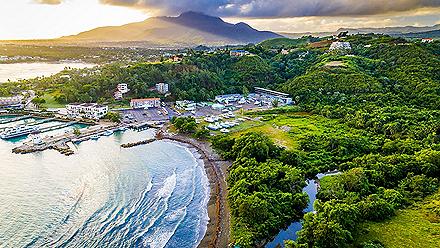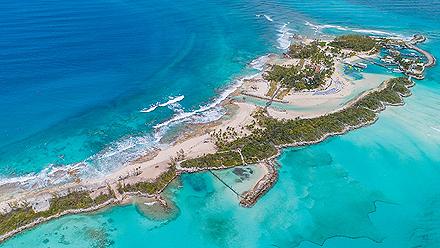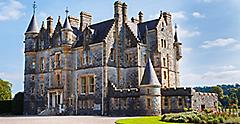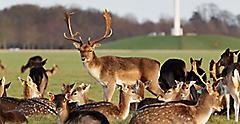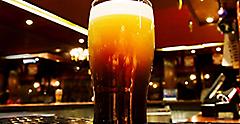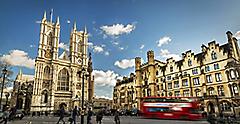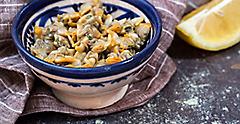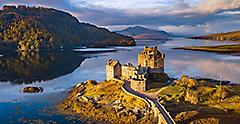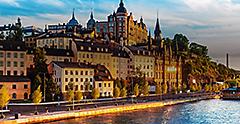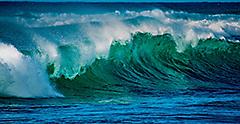
From rugged cliffs to rowdy pubs and rolling countryside, Ireland has something for everyone.
Known as the Emerald Isle, Ireland is characterized by its rolling green hills and lush countryside, dotted with friendly country towns, dry stone walls and crumbling castles. Cruise to Ireland to visit the Cliffs of Moher, a UNESCO Global Geopark, about a two-hour drive from Cork, to see where the bright blue waters meet towering sea cliffs, or head to Cork's Blarney Castle to be granted the gift of gab by kissing the famous Blarney Stone. To step back in time, see Dublin's Malahide Castle, dating back to the 12th century. Don't leave without enjoying a pint of Guinness and listening to traditional Irish music at a local pub on Dublin's Fleet Street or Grafton Street.
Rich And Lush Landscapes
Unforgettable cruise vacation
Get Royal Deals, Sign Up Today

CLING TO THE CLIFFS
Over one million people visit the Cliffs of Moher annually, and you could be one of them — they're about a two-hour drive away from Cork. Witness the majesty of Ireland's top natural attraction, which stretches for five miles and rises up to 214 meters. Be prepared, though: The Atlantic sea breeze at the Cliffs of Moher can literally blow you away.
ENJOY THE KNIGHT LIFE
Get the gift of gab at Cork's famous Blarney Castle, where you'll find the Blarney Stone, which legend says will bestow on you the gift of eloquence (but only if you can bend over backwards to kiss it). Or explore the 12th-century Romanesque architecture of the Rock of Cashel, Ireland's most-visited heritage site, about an hour's drive from Waterford.
GO GREEN
To connect with nature in the middle of the city center, head to St. Stephen's Green in Dublin, where you can find an ornamental lake and several walking paths. If you're looking for an animal adventure during your Ireland vacation, visit Phoenix Park, one of the largest enclosed recreational spaces in any European capital city and home to the Dublin Zoo and roaming deer.
HIT THE HILLS
Just outside the city center, the Belfast Hills offer stunning views of Northern Ireland's expressive capital city and the surrounding bay. The Castle Trail up Cave Hill will take you to these sights in an easygoing 30-minute hike.
FOLLOW THE RAINBOW
A cruise to Ireland brings you to some of the world's most charming and colorful towns. In Cork, pastel-colored homes line the waterfront, and nearby Kinsale's downtown area is home to streets with brightly colored shops in purple, green and virtually every other hue imaginable selling books, art, crafts and local trinkets.
POUR A PINT
Incredibly, there are over 750 pubs in Dublin and its surrounding area, so you never have to wander far for a drink. Temple Bar is the most popular area in town for a pint, but the best place to grab a Guinness is the Guinness Storehouse. Learn how the beer is made before pouring your own perfect pint.
DUBLIN DAY TRIPPIN'
Although you can cross the coast to the Cliffs of Moher within a day, there are other doable day trips closer to Dublin, too. Wicklow is nicknamed the Garden of Ireland and is home to Wicklow Mountains National Park. Step into the past at the seaside town of Howth and Malahide Castle, which has parts remaining from the 12th century.

FEEL THE LUCK OF THE IRISH ON THIS
ISLAND ADVENTURE
Explore Dublin, with its cobblestone streets, nightlife, museums and green spaces. Then head into to the Irish countryside, dominated by colorful villages, greenery as far as the eye can see and breathtakingly rugged landscapes. And don't miss out on popular attractions such as "Game of Thrones" sightseeing and Titanic history in Belfast.
BEHOLD THE BRITISH ISLES
Don't stop at just one British Isle. Belfast and Northern Ireland are a doable day trip from Dublin, and charming cities like London and Edinburgh are just a stone's throw across the Irish Sea. Just remember that once you cross the border, the British Pound is the main form of currency.
TAKE ON THE TRANSATLANTIC
Crossing the Atlantic on a cruise from Europe to the United States is an adventure of a lifetime. On transatlantic cruises, you'll visit tropical ports like the Bahamas and Puerto Rico, but you can also head to the icy ports of Greenland and Iceland, if that's more your style.
WHAT TO KNOW
BEFORE YOU GO
Irish You Were Here
There's a lot to see and do in Ireland with your cruise. Here are some helpful hints for getting around the Emerald Isle.
Ireland is so lush because it frequently rains. The country's weather is unpredictable year-round, so always pack a waterproof jacket, comfortable waterproof shoes and an umbrella just in case.
You can visit Ireland anytime of the year, but summer is the busiest season. Visiting in the shoulder vacation seasons of spring and autumn will let you avoid large crowds.
Many attractions and things to do are closed on Sundays, so try to plan for museum visits and castle-hopping on Monday through Saturday.
1
If you're planning to drive around on a day trip, remember that Irish road signs are in kilometers — 10 km is just over 6 miles, so things may be a little closer than you think.
2
If your day trip will involve train travel instead, book your Irish Rail tickets in advance to receive discounts and guaranteed travel.
3
Tipping isn't customary in Ireland, but take a look at your bill because some restaurants will add a 10 percent service charge to the bill.
CUISINE
STIR THE POT
Irish food is synonymous with comfort. Whether it's a hearty Irish stew or traditional bacon and cabbage, Ireland's cuisine is all about stick-to-your ribs satisfaction — all served with an equally comforting pint of Guinness, of course.
SLURP'S UP
Irish stews come in many forms, but the three key ingredients are lamb, potatoes and onion. Carrots often make an appearance in the dish's rich broth, and the addition of thyme complements the gamey flavors of the lamb. You'll find traditional Irish stew on most pub menus.
BACON ME HUNGRY
Bacon and cabbage is a simple but beloved Irish dish. It includes sliced back bacon — which is thick-cut and steak-like rather than thin and crispy — boiled with traditional cabbage and potatoes. It's often prepared with spicy mustard seeds and fresh parsley or another herb sauce to balance out the hearty flavors.
CRACK OPEN COCKLES
Made famous in the Irish tune "Molly Malone," cockles are small saltwater clams found along the Irish coastline, and they've become a local delicacy. They're usually served boiled alongside mussels, or in a chowder-like soup with a creamy, buttery broth.




